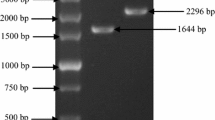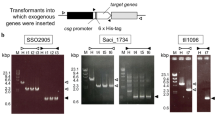Abstract
A major carotenoid in Sphingomonas sp. PB304, originally isolated from a river in Daejon City, South Korea, was identified as astaxanthin dideoxyglycoside. Gene clusters encoding the astaxanthin dideoxyglycoside biosynthetic enzymes were identified by screening Sphingomonas sp. PB304 fosmid libraries using degenerate probes that harbor highly conserved sequences from the Sphigomonas elodea-derived crtI and Nostoc sp. PCC 7120-dervied crtW genes. Selected positive gene clusters were fully sequenced and annotated, revealing genes encoding six putative carotenogenic enzymes: phytoene synthase (CrtB), phytoene desaturase (CrtI), lycopene cyclase (CrtY), carotene hydroxylase (CrtZ), carotene ketolase (CrtW), and glycosyltransferase (CrtX). All of the carotenogenic enzymes, except for CrtX, were functional in the recombinant host Escherichia coli expressing synthetic carotenogenic modules from Pantoea agglomerans. CrtX did not take up UDP-glucose or GDP-fucose as sugar substrates during the in vitro reaction. Although no direct experimental evidence was obtained for the function of Sphingomonas sp. PB304 CrtX, it can be categorized as a putative deoxyglycosyltransferase based on the presence of astaxanthin dideoxyglycoside in Sphingomonas sp. PB304, a putative corresponding gene in the carotenoid biosynthetic gene cluster, and high amino acid sequence homology to the existing glycosyltransferases. Therefore, we propose that astaxanthin dideoxyglycoside can be synthesized in Sphingomonas sp. PB304 via sequential reactions of six pathway enzymes, including CrtX on the phytoene intermediate.






Similar content being viewed by others
References
An G, Schuman DB, Johnson EA (1989) Isolation of Phaffia rhodozyma mutants with increased astaxanthin content. Appl Environ Microbiol 55:116–124
Asker D, Beppu T, Ueda K (2007a) Sphingomonas astaxanthinifaciens sp. nov., a novel astaxanthin-producing bacterium of the family Sphingomonadaceae isolated from Misasa, Tottori, Japan. FEMS Microbiol Lett 273:140–148
Asker D, Beppu T, Ueda K (2007b) Unique diversity of carotenoid-producing bacteria isolated from Misasa, a radioactive site in Japan. Appl Microbiol Biotechnol 77:383–392
Asker D, Amano SI, Morita K, Tamura K, Sakuda S, Kikuchi N, Furihata K, Matsufuji H, Beppu T, Ueda K (2009) Astaxanthin dirhamnoside, a new astaxanthin derivative produced by a radio-tolerant bacterium, Sphingomonas astaxanthinifaciens. J Antibiot 62:397–399
Britton G (1995) Structure and properties of carotenoids in relation to function. FASEB J 9:1551–1558
Cazzonelli CI (2011) Carotenoids in nature: insights from plants and beyond. Funct Plant Biol 38:833–847
Dembitsky VM (2005) Astonishing diversity of natural surfactants: 3. Carotenoid glycosides and isoprenoid glycolipids. Lipids 40:535–557
Felsenstein J (1985) Confidence limits on phylogenies: an approach using the bootstrap. Evolution 39:783–791
Graham JE, Bryant DA (2009) The biosynthetic pathway for myxol-2′ fucoside (myxoxanthophyll) in the cyanobacterium Synechococcus sp. strain PCC 7002. J Bacteriol 191:3292–3300
Heider SAE, Peters-Wendisch P, Netzer R, Stafnes M, Brautaset T, Wendisch VF (2014) Production and glucosylation of C50 and C40 carotenoids by metabolically engineered Corynebacterium glutamicum. Appl Microbiol Biotechnol 98:1223–1235
Hundle BS, O’Brien DA, Alberti M, Beyer P, Hearst JE (1992) Functional expression of zeaxanthin glucosyltransferase from Erwinia herbicola and a proposed uridine diphosphate binding site. Proc Natl Acad Sci U S A 89:9321–9325
Jukes TH, Cantor CR (1969) Evolution of protein molecules. Academic, New York, pp 21–132
Kakirde KS, Parsley LC, Liles MR (2010) Size does matter: application-driven approaches for soil metagenomics. Soil Biol Biochem 42:1911–1923
Kim SH, Lee PC (2012) Functional expression and extension of staphylococcal staphyloxanthin biosynthetic pathway in Escherichia coli. J Biol Chem 287:21575–21583
Kim SH, Park YH, Schmidt-Dannert C, Lee PC (2010) Redesign, reconstruction, and directed extension of the Brevibacterium linens C40 carotenoid pathway in Escherichia coli. Appl Environ Microbiol 76:5199–5206
Kim OS, Cho YJ, Lee K, Yoon SH, Kim M, Na H, Park SC, Jeon YS, Lee JH, Yi H, Won S, Chun J (2012) Introducing EzTaxon-e: a prokaryotic 16S rRNA gene sequence database with phylotypes that represent uncultured species. Int J Syst Evol Microbiol 62:716–721
Krubasik P, Sandmann G (2000) A carotenogenic gene cluster from Brevibacterium linens with novel lycopene cyclase genes involved in the synthesis of aromatic carotenoids. Mol Gen Genet 263:423–432
Krubasik P, Takaichi S, Maoka T, Kobayashi M, Masamoto K, Sandmann G (2001) Detailed biosynthetic pathway to decaprenoxanthin diglucoside in Corynebacterium glutamicum and identification of novel intermediates. Arch Microbiol 176:217–223
Larkin MA, Blackshields G, Brown NP, Chenna R, McGettigan PA, McWilliam H, Valentin F, Wallace IM, Wilm A, Lopez R, Thompson JD, Gibson TJ, Higgins DG (2007) Clustal W and Clustal X version 2.0. Bioinformatics 23:2947–2948
Lee PC, Schmidt-Dannert C (2002) Metabolic engineering towards biotechnological production of carotenoids in microorganisms. Appl Microbiol Biotechnol 60:1–11
Lee PC, Momen AZR, Mijts BN, Schmidt-Dannert C (2003) Biosynthesis of structurally novel carotenoids in Escherichia coli. Chem Biol 10:453–462
Maresca JA, Bryant DA (2006) Two genes encoding new carotenoid-modifying enzymes in the green sulfur bacterium Chlorobium tepidum. J Bacteriol 188:6217–6223
Misawa N, Nakagawa M, Kobayashi K, Yamano S, Izawa Y, Nakamura K, Harashima K (1990) Elucidation of the Erwinia uredovora carotenoid biosynthetic pathway by functional analysis of gene products expressed in Escherichia coli. J Bacteriol 172:6704–6712
Mohamed HE, van de Meene AML, Roberson RW, Vermaas WFJ (2005) Myxoxanthophyll is required for normal cell wall structure and thylakoid organization in the cyanobacterium Synechocystis sp. strain PCC 6803. J Bacteriol 187:6883–6892
Moraga AR, Nohales PF, Pérez JAF, Gómez-Gómez L (2004) Glucosylation of the saffron apocarotenoid crocetin by a glucosyltransferase isolated from Crocus sativus stigmas. Planta 219:955–966
Netzer R, Stafsnes MH, Andreassen T, Goksøyr A, Bruheim P, Brautaset T (2010) Biosynthetic pathway for γ-cyclic sarcinaxanthin in micrococcus luteus: heterologous expression and evidence for diverse and multiple catalytic functions of C50 carotenoid cyclases. J Bacteriol 192:5688–5699
Nishino H, Murakoshi M, Tokuda H, Satomi Y (2009) Cancer prevention by carotenoids. Arch Biochem Biophys 483:165–168
Oh H-M, Kang I, Vergin KL, Kang D, Rhee K-H, Giovannoni SJ, Cho JC (2011) Complete genome sequence of strain HTCC2503T of Parvularcula bermudensis, the type species of the order “Parvularculales” in the class alphaproteobacteria. J Bacteriol 193:305–306
Pelz A, Wieland KP, Putzbach K, Hentschel P, Albert K, Götz F (2005) Structure and biosynthesis of staphyloxanthin from Staphylococcus aureus. J Biol Chem 280:32493–32498
Saitou N, Nei M (1987) The neighbor-joining method: a new method for reconstructing phylogenetic trees. Mol Biol Evol 4:406–425
Schmidt EW, Nelson JT, Rasko DA, Sudek S, Eisen JA, Haygood MG, Ravel J (2005) Patellamide A and C biosynthesis by a microcin-like pathway in Prochloron didemni, the cyanobacterial symbiont of Lissoclinum patella. Proc Natl Acad Sci U S A 102:7315–7320
Seo YB, Choi SS, Nam SW, Lee JH, Kim YT (2009) Cloning and characterization of the zeaxanthin glucosyltransferase gene (crtX) from the astaxanthin-producing marine bacterium, Paracoccus haeundaensis. J Microbiol Biotechnol 19:1542–1546
Shumskaya M, Wurtzel ET (2013) The carotenoid biosynthetic pathway: thinking in all dimensions. Plant Sci 208:58–63
Song GH, Kim SH, Choi BH, Han SJ, Lee PC (2013) Heterologous carotenoid-biosynthetic enzymes: functional complementation and effects on carotenoid profiles in Escherichia coli. Appl Environ Microbiol 79:610–618
Takaichi S, Mochimaru M (2007) Carotenoids and carotenogenesis in cyanobacteria: unique ketocarotenoids and carotenoid glycosides. Cell Mol Life Sci 64:2607–2619
Takaichi S, Maoka T, Takasaki K, Hanada S (2010) Carotenoids of Gemmatimonas aurantiaca (Gemmatimonadetes): identification of a novel carotenoid, deoxyoscillol 2-rhamnoside, and proposed biosynthetic pathway of oscillol 2,2′-dirhamnoside. Microbiology 156:757–763
Takeuchi M, Hamana K, Hiraishi A (2001) Proposal of the genus Sphingomonas sensu stricto and three new genera, Sphingobium, Novosphingobium and Sphingopyxis, on the basis of phylogenetic and chemotaxonomic analyses. Int J Syst Evol Microbiol 51:1405–1417
Tamura K, Stecher G, Peterson D, Filipski A, Kumar S (2013) MEGA6: molecular evolutionary genetics analysis version 6.0. Mol Biol Evol 30:2725–2729
Tao L, Yao H, Cheng Q (2007) Genes from a Dietzia sp. for synthesis of C40 and C50 β-cyclic carotenoids. Gene 386:90–97
Walter MH, Strack D (2011) Carotenoids and their cleavage products: biosynthesis and functions. Nat Prod Rep 28:663–692
Yabuuchi E, Yano I, Oyaizu H, Hashimoto Y, Ezaki T, Yamamoto H (1990) Proposals of Sphingomonas paucimobilis gen. nov. and comb. nov., Sphingomonas parapaucimobilis sp. nov., Sphingomonas yanoikuyae sp. nov., Sphingomonas adhaesiva sp. nov., Sphingomonas capsulata comb. nov., and two genospecies of the genus Sphingomonas. Microbiol Immunol 34:99–119
Yi T, Han CK, Srinivasan S, Lee K, Kim M (2010) Sphingomonas humi sp. nov., isolated from soil. J Microbiol 48:165–169
Zhu L, Wu X, Li O, Chen Y, Qian C, Teng Y, Tao X, Gao H (2011) Cloning and knockout of phytoene desaturase gene in Sphingomonas elodea ATCC 31461 for economic recovery of gellan gum. J Ind Microbiol Biotechnol 38:1507–1513
Zhu L, Wu X, Li O, Qian C, Gao H (2012) Cloning and characterization of genes involved in nostoxanthin biosynthesis of Sphingomonas elodea ATCC 31461. PLoS One 7:e35099. doi:10.1371/journal.pone.0035099
Acknowledgments
Sphingomonas sp. PB304 was kindly provided by Prof. Kyung-Ho Kim. This work was supported by the National Research Foundation of Korea grants funded by the Korean Government (2014029244; NRF-2013R1A1A2007127).
Conflict of interest
The authors have no conflict of interest to declare.
Author information
Authors and Affiliations
Corresponding author
Electronic supplementary material
Below is the link to the electronic supplementary material.
ESM 1
(PDF 313 kb)
Rights and permissions
About this article
Cite this article
Kim, S.H., Kim, J.H., Lee, B.Y. et al. The astaxanthin dideoxyglycoside biosynthesis pathway in Sphingomonas sp. PB304. Appl Microbiol Biotechnol 98, 9993–10003 (2014). https://doi.org/10.1007/s00253-014-6050-7
Received:
Revised:
Accepted:
Published:
Issue Date:
DOI: https://doi.org/10.1007/s00253-014-6050-7




